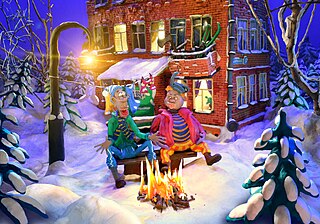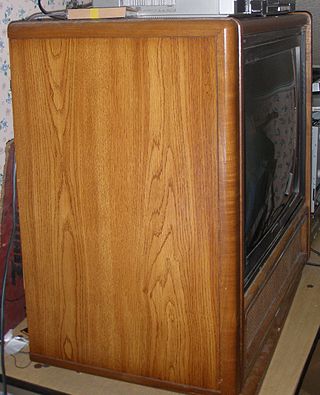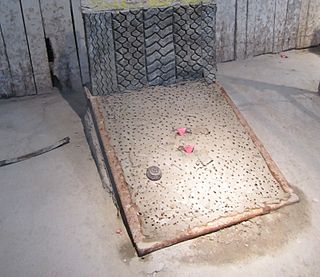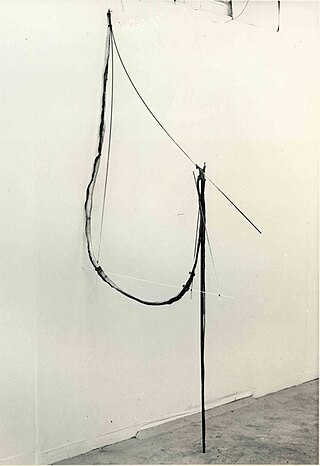
Animation is a method by which still figures are manipulated to appear as moving images. In traditional animation, images are drawn or painted by hand on transparent celluloid sheets to be photographed and exhibited on film. Today, many animations are made with computer-generated imagery (CGI). Computer animation can be very detailed 3D animation, while 2D computer animation can be used for stylistic reasons, low bandwidth, or faster real-time renderings. Other common animation methods apply a stop motion technique to two- and three-dimensional objects like paper cutouts, puppets, or clay figures.
Aardman Animations Limited is a British animation studio based in Bristol, England. It is known for films made using stop-motion and clay animation techniques, particularly those featuring its plasticine characters Wallace and Gromit, Shaun the Sheep, and Morph. After some experimental computer-animated short films during the late 1990s, beginning with Owzat (1997), Aardman entered the computer animation market with Flushed Away (2006). As of February 2020, it had earned $1.1 billion worldwide, with an average $134.7 million per film.
Oskar Wilhelm Fischinger was a German-American abstract animator, filmmaker, and painter, notable for creating abstract musical animation many decades before the appearance of computer graphics and music videos. He created special effects for Fritz Lang's 1929 Woman in the Moon, one of the first sci-fi rocket films, and influenced Disney's Fantasia. He made over 50 short films and painted around 800 canvases, many of which are in museums, galleries, and collections worldwide. Among his film works is Motion Painting No. 1 (1947), which is now listed on the National Film Registry of the U.S. Library of Congress.

Clay animation or claymation, sometimes plasticine animation, is one of many forms of stop-motion animation. Each animated piece, either character or background, is "deformable"—made of a malleable substance, usually plasticine clay.

Histopathology refers to the microscopic examination of tissue in order to study the manifestations of disease. Specifically, in clinical medicine, histopathology refers to the examination of a biopsy or surgical specimen by a pathologist, after the specimen has been processed and histological sections have been placed onto glass slides. In contrast, cytopathology examines free cells or tissue micro-fragments.

The Lorne sausage, also known as square sausage or slice, is a traditional Scottish food item made from minced meat, rusk and spices. Although termed a sausage, no casing is used to hold the meat in shape, hence it is usually served as square slices from a formed block. It is a common component of the traditional Scottish breakfast.

Tunbridge ware is a form of decoratively inlaid woodwork, typically in the form of boxes, that is characteristic of Tonbridge and the spa town of Royal Tunbridge Wells in Kent in the 18th and 19th centuries. The decoration typically consists of a mosaic of many very small pieces of different coloured woods that form a pictorial vignette. Shaped rods and slivers of wood were first carefully glued together, then cut into many thin slices of identical pictorial veneer with a fine saw. Elaborately striped and feathered bandings for framing were pre-formed in a similar fashion.

In woodworking, veneer refers to thin slices of wood and sometimes bark, usually thinner than 3 mm, that typically are glued onto core panels to produce flat panels such as doors, tops and panels for cabinets, parquet floors and parts of furniture. They are also used in marquetry. Plywood consists of three or more layers of veneer. Normally, each is glued with its grain at right angles to adjacent layers for strength. Veneer beading is a thin layer of decorative edging placed around objects, such as jewelry boxes. Veneer is also used to replace decorative papers in wood veneer HPL.

Walter Ruttmann was a German cinematographer and film director, an important German abstract experimental film maker, along with Hans Richter, Viking Eggeling and Oskar Fischinger. He is best known for directing the semi-documentary 'city symphony' silent film, with orchestral score by Edmund Meisel, in 1927, Berlin: Symphony of a Metropolis. His audio montage Wochenende (Weekend) (1930) is considered a major contribution in the development of audio plays.

Motion graphics are pieces of animation or digital footage which create the illusion of motion or rotation, and are usually combined with audio for use in multimedia projects. Motion graphics are usually displayed via electronic media technology, but may also be displayed via manual powered technology. The term distinguishes static graphics from those with a transforming appearance over time, without over-specifying the form. While any form of experimental or abstract animation can be called motion graphics, the term typically more explicitly refers to the commercial application of animation and effects to video, film, TV, and interactive applications.

Tejo, also known, to a lesser degree, as turmequé, is a traditional throwing sport in Colombia. It is characteristic of its use of small targets containing gunpowder, which explode on impact.

Pin Art or Pinscreen is an executive toy patented in 1987 by Ward Fleming. It consists of a boxed surface made of a crowded array of pins that are free to slide in and out independently in a screen to create a three-dimensional relief. Other similar product names are "PinPressions" and "Pinhead". The original Pinscreen toys were made of metal pins, which were heavier and tended to bend easily; newer Pinscreen toys are generally made of plastic pins. Pinscreens have also been used for animation production; a larger device working on a similar principle was invented by Claire Parker in 1935.
The following outline is provided as an overview of and topical guide to animation:
BENT IMAGE LAB is a production company and animation studio specializing in story development, television, commercials, visual effects, music videos, short films, experimental techniques and tech development in augmented reality (AR). Located in Portland, Oregon, the company was founded in 2002 by partners David Daniels, Ray Di Carlo, and Chel White.

Steven Woloshen is a Canadian film animator and a pioneer of drawn-on-film animation.
David Daniels is an American commercial director, filmmaker, and co-founder of the Portland, Oregon based animation studio Bent Image Lab.

Shelagh Cluett was an artist and fine art lecturer working in London, England, from the late 1960s until 2007. Cluett became a recognised figure on the London art scene in the early 1980s with exhibitions of her large metal sculptures appearing internationally. She worked at Chelsea School of Art and Design as a lecturer, and after 25 years, took up the position of Head of Postgraduate Studies in 2006.
Non-narrative film is an aesthetic of cinematic film that does not narrate, or relate "an event, whether real or imaginary". It is usually a form of art film or experimental film, not made for mass entertainment.

The Rig is a British supernatural thriller television series created by David Macpherson for Amazon Prime Video. The series is directed by John Strickland, and is the first Amazon Original to be filmed entirely in Scotland. The series was released on 6 January 2023 and consists of six episodes. In February 2023, the series was renewed for a second season.













